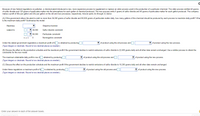
Advanced Engineering Mathematics
10th Edition
ISBN: 9780470458365
Author: Erwin Kreyszig
Publisher: Wiley, John & Sons, Incorporated
expand_more
expand_more
format_list_bulleted
Concept explainers
Topic Video
Question

Transcribed Image Text:Because of new federal regulations on pollution, a chemical plant introduced a new, more expensive process to supplement or replace an older process used in the production of a particular chemical. The older process emitted 40 grams
of sulfur dioxide and 120 grams of particulate matter into the atmosphere for each gallon of chemical produced. The new process emits 5 grams of sulfur dioxide and 40 grams of particulate matter for each gallon produced. The company
makes a profit of 80¢ per gallon and 20¢ per gallon on the old and new processes, respectively. Answer parts (A) through (C) below.
(A) If the government allows the plant to emit no more than 36,000 grams of sulfur dioxide and 90,000 grams of particulate matter daily, how many gallons of the chemical should be produced by each process to maximize daily profit? Wha
is the maximum daily profit? Summarize the model,
Maximize
Objective function
subject to
V 36,000
Sulfur dioxide constraint
V 90,000
Particulate constraint
х, у 2
Nonnegative constraint
Under the stated government regulations a maximum profit of $ is obtained by producing
of product using the old process and
of product using the new process.
(Type integers or decimals. Round to two decimal places as needed.)
(B) Discuss the effect on the production schedule and the maximum profit if the government decides to restrict emissions of sulfur dioxide to 22,400 grams daily and all other data remain unchanged. Use a similar process to obtain the
constraints for the new model.
The maximum obtainable daily profit is now $ obtained by producing
(Type integers or decimals. Round to two decimal places as needed.)
V of product using the old process and
V of product using the new process.
(C) Discuss the effect on the production schedule and the maximum profit if the government decides to restrict emissions of sulfur dioxide to 10,200 grams daily and all other data remain unchanged.
Under these regulations a maximum profit of S is obtained by producing
(Type integers or decimals. Round to two decimal places as needed.)
of product using the old process and
of product using the new process.
Enter your answer in each of the answer boxes.
Expert Solution
This question has been solved!
Explore an expertly crafted, step-by-step solution for a thorough understanding of key concepts.
This is a popular solution
Trending nowThis is a popular solution!
Step by stepSolved in 4 steps with 1 images

Knowledge Booster
Learn more about
Need a deep-dive on the concept behind this application? Look no further. Learn more about this topic, advanced-math and related others by exploring similar questions and additional content below.Similar questions
- An editorial in the New York Times on Sunday June 4, 2011 dicussed the redesigned fuel economy stickers to be required on new cars starting in 2013. Consider a new idsize fuord fusion s model. At $4-a-gallon gas, annual fuel costs would be about $2,200 for 15,000 miles driven... And thats for a car with a rated mileage of 34.9m.p.g. actual highway mileage, as with all vehicles, is lower, in this case about 27m.p.g. Industry clearly needs to do better. Did the times use the rated or the actual mileage in its computation?arrow_forwardAutomotive Trades Europeans commonly express gas mileage in “liters per 100 km" (L/100 km), whereas North Americans express mileage in miles per gallon (mi/gal). If a European car has a mileage rating of 6.5 L per 100 km, how would this be expressed in North America?arrow_forwardThe Dorben Co. uses a standard hour plan with a base wage of $9/h. It hires an IE consultant to plan a batch production run of 300 units. This consultant has a worker on the line produce 2 units. The first takes 10 min and the second 9.7 min. Assuming that the worker continues to improve her performance, what will she be paid for the full batch of 300 units under the standard hour plan? What is the unit cost for the first unit made? What is the cost for 300th unit? there is already an answer for this question in chegg but it does not explain clearly in steps. I need some clear explanation thnksarrow_forward
- Lise Meitner bombarded 300 uranium atoms with a stream of neutrons for 10 seconds each. She recorded the energy released when the uranium atom was split. What is the sample of this study?arrow_forwardClose to three-fourths of the Earth is covered with water. About what percent of the Earth is covered with water?arrow_forward
arrow_back_ios
arrow_forward_ios
Recommended textbooks for you
 Advanced Engineering MathematicsAdvanced MathISBN:9780470458365Author:Erwin KreyszigPublisher:Wiley, John & Sons, Incorporated
Advanced Engineering MathematicsAdvanced MathISBN:9780470458365Author:Erwin KreyszigPublisher:Wiley, John & Sons, Incorporated Numerical Methods for EngineersAdvanced MathISBN:9780073397924Author:Steven C. Chapra Dr., Raymond P. CanalePublisher:McGraw-Hill Education
Numerical Methods for EngineersAdvanced MathISBN:9780073397924Author:Steven C. Chapra Dr., Raymond P. CanalePublisher:McGraw-Hill Education Introductory Mathematics for Engineering Applicat...Advanced MathISBN:9781118141809Author:Nathan KlingbeilPublisher:WILEY
Introductory Mathematics for Engineering Applicat...Advanced MathISBN:9781118141809Author:Nathan KlingbeilPublisher:WILEY Mathematics For Machine TechnologyAdvanced MathISBN:9781337798310Author:Peterson, John.Publisher:Cengage Learning,
Mathematics For Machine TechnologyAdvanced MathISBN:9781337798310Author:Peterson, John.Publisher:Cengage Learning,


Advanced Engineering Mathematics
Advanced Math
ISBN:9780470458365
Author:Erwin Kreyszig
Publisher:Wiley, John & Sons, Incorporated

Numerical Methods for Engineers
Advanced Math
ISBN:9780073397924
Author:Steven C. Chapra Dr., Raymond P. Canale
Publisher:McGraw-Hill Education

Introductory Mathematics for Engineering Applicat...
Advanced Math
ISBN:9781118141809
Author:Nathan Klingbeil
Publisher:WILEY

Mathematics For Machine Technology
Advanced Math
ISBN:9781337798310
Author:Peterson, John.
Publisher:Cengage Learning,

